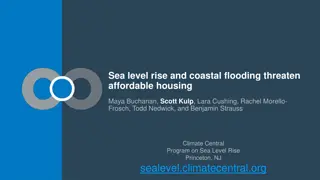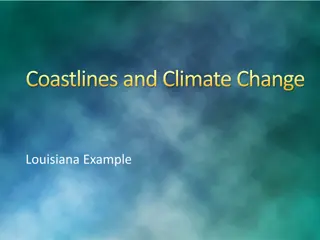Impacts of Sea Level Rise on Economic Growth and Capital
Sea level rise, caused by factors like thermal expansion and ice melting, has accelerated in recent years, leading to significant impacts on natural, physical, and social capital. Loss of land affects agricultural production and economic output, while the destruction of infrastructure and productive capital in coastal areas poses challenges. Understanding and mitigating these economic impacts is crucial for sustainable development.
Download Presentation

Please find below an Image/Link to download the presentation.
The content on the website is provided AS IS for your information and personal use only. It may not be sold, licensed, or shared on other websites without obtaining consent from the author.If you encounter any issues during the download, it is possible that the publisher has removed the file from their server.
You are allowed to download the files provided on this website for personal or commercial use, subject to the condition that they are used lawfully. All files are the property of their respective owners.
The content on the website is provided AS IS for your information and personal use only. It may not be sold, licensed, or shared on other websites without obtaining consent from the author.
E N D
Presentation Transcript
Sea Level Rise: Potential Economic Impacts; Preparation; Government Policy Bahaa Judeh Environmental Economics ECON 2505 Prof. Sean P. MacDonald 5/17/17
What is Sea Level Rise? An increase in the volume of water in the world s oceans, resulting in an increase in global mean sea level, mainly caused by: Thermal Expansion caused by warming of the ocean (water expands as it warms) Increased melting of land-based ice, such as glaciers and ice sheets. The oceans are absorbing more than 90% of the increased atmospheric heat associated with emissions from human activity.
The pace of global sea level rise almost doubled from 1.7 mm/year throughout most of the twentieth century to 3.2 mm/year since 1993.
Why does it matter? In the United States, almost 40% of the population lives in relatively high population-density coastal areas, where sea level plays a role in flooding, shoreline erosion, and hazards from storms. Globally, 8 of the world s 10 largest cities are near a coast, according to the U.N. Atlas of the Oceans.
Glacier mass loss accelerated from 226 gigatons/year between 1971 and 1992 to 275 gigatons/year between 1993 and 2009. Ice loss from the Greenland Ice Sheet increased six-fold, from 34 gigatons/year between 1992-2001 to 215 gigatons/year between 2002 and 2011. Antarctic ice loss more than quadrupled, from 30 gigatons/year between 1992 and 2001 to 147 gigatons/year from 2002 to 2011.
Impact on Economic Growth 1. Permanent losses of natural capital Sea level rise will lead to the definitive loss of land. Land is a natural resource and matters for economic production. Land is part of natural capital, thus, a loss of land is a loss of capital with negative consequences on output. This loss will affect particularly agricultural production. Where land is scarce (or, equivalently, where all useable land is used for agriculture), the associated economic cost can be assessed by the land market value.
Impact on Economic Growth 2. Permanent loss of physical capital Sea level rise can lead to the loss of infrastructure and productive capital to a loss of physical capital. In some coastal areas, indeed, it is more rational to withdraw inland than to try to protect the area. 3. Permanent loss of social capital Sea level rise might also affect social capital. A fraction of the population would be affected by sea level rise and would require additional protection expenditures and support. This could create political and social tensions since policies would have large redistributive effects: if large investments are made, the rest of the population can see them as inappropriate; if necessary investments are not made, the population at risk may feel unprotected by its government.
Impact on Economic Growth 4. Temporary floods and their impacts Many low-lying coastal land areas are expected to be gradually submerged by rising sea levels. A rise of two feet above today's sea level would put more than $1 trillion of property and structures in the U.S. at risk of inundation. And this effect is reinforced by existing trends, with cities especially coastal cities growing rapidly in response to trends in economic structure and life styles. Confronted with growing population, land scarcity and infrastructure gap, more marginal and high-risk land is urbanized every year.
Government Government must weigh the costs and risks of accommodating the rising seas, retreating from them, or trying to defend coastal properties and infrastructure with protective measures: Traditional defensive approaches such as building seawalls and levees, or replenishing sand along eroded beaches, can help protect against flooding and damage but may not provide adequate or sustainable long- term protection. Maintaining or restoring natural buffers, such as barrier islands, tidal wetlands, and mangroves, can also help defend coastlines. Measures like elevating and flood-proofing structures can help accommodate temporary flooding and gradual inundation. The most vulnerable coastal communities may increasingly need to consider the stark option of some form of retreat from the rising seas. To limit the long-term risks of sea level rise and the costs of adapting to it, we must work toward deep reductions in the global warming emissions that are the primary cause of rising sea levels.
Preparation https://www.youtube.com/ watch?v=nCXScCHcrgU Following Hurricane Sandy, local and federal officials partnered with developers in New York City to address infrastructure deficiencies in Manhattan. The result was a resiliency master plan by architect Bjarke Ingels and his firm, BIG. Named "The Big U," the Ingels plan is to raise the city's seawall and create green space along the water.
Works Cited Causes of Sea Level Rise: What the Science Tells Us | Union of Concerned Scientists. (2013). Retrieved from http://www.ucsusa.org/globalwarming/science and_impacts/impacts/causes- of-sea-level-rise.html#.WRw7omgrLIX US Department of Commerce, National Oceanic and Atmospheric Administration. (2008, October 27). Is sea level rising? Retrieved from http://oceanservice.noaa.gov/facts /sea level.html Hallegatte, S. Insight: how will sea-level rise affect economic growth? Retrieved from http://environmentalresearchweb.org/cws/article/news/49112 Martin, D. (2016, June 20). How New York, Miami and Boston Are Preparing For Rising Sea Levels. Retrieved from https://www.forbes.com/sites/dmartin /2016/06/20/ combatting-sea-level-rise-requires-a-long-term- view/#7f121595237d Lindsey, R. (2016, June 10). Climate Change: Global Sea Level | NOAA Climate.gov. Retrieved from https://www.climate.gov/news- features/understanding-climate/climate-change-global-sea-level























